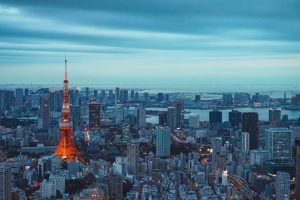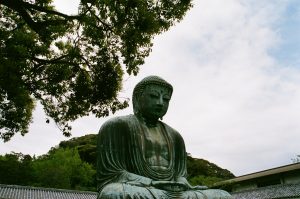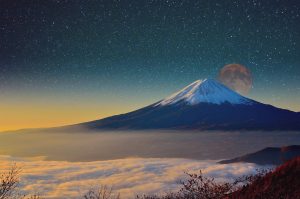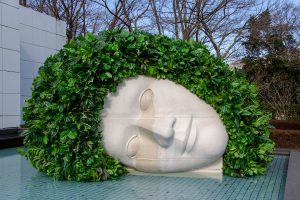Day 1 – Tokyo
 Tsukiji Fish Market is the largest fish market in the world, and as time has gone on it’s become one of the most authentic and special tourist attractions in Tokyo.
Tsukiji Fish Market is the largest fish market in the world, and as time has gone on it’s become one of the most authentic and special tourist attractions in Tokyo.
Senso-ji Temple also known as Asakusa Kannon and located in Tokyo’s Asakusa district, is the city’s oldest religious building and one of its most colorful and popular. With roughly 20 million annual visitors, it’s also the most visited-temple in Japan and the most-frequented spiritual site in the world.
Tokyo Skytree The observation decks are located on the 45th floor of their respective towers and offer views from 202 meters above the ground. From the Tocho it is possible to see Meiji Jingu, Tokyo Tower, the Tokyo Skytree and Mount Fuji. With a whopping height of 634 meters, Tokyo Skytree was recognized as the world’s tallest tower by Guinness World Records on November 11, 2011.
Imperial Palace is the residence of Japan’s Imperial Family. Edo Castle used to be the seat of the Tokugawa shogun who ruled Japan from 1603 until 1867. Enjoy the visit to The East Garden of the Imperial Palace. Prior booking is required if you are interested to see inside the palace.
Akihabara is a buzzing shopping hub famed for its electronics retailers, ranging from tiny stalls to vast department stores like Yodobashi Multimedia Akiba. Venues specializing in manga, anime, and video games include Tokyo Anime Center, for exhibits and souvenirs, and Radio Kaikan with 10 floors of toys, trading cards, and collectibles. Staff dressed as maids or butlers serve tea and desserts at nearby maid cafes.
Meiji Jingu Shrine is surrounded by a lush green forest right in the heart of Tokyo, Meiji Shrine is a Shinto shrine in Shibuya, Tokyo, that is dedicated to the deified spirits of Emperor Meiji and his wife, Empress Shōken. The shrine does not contain the emperor’s grave, which is located at Fushimi-momoyama, south of Kyoto.
Takeshita Street is popular street in Harajuku known for wacky, youth-driven shops selling colorful and crazy clothes and accessories. It’s also a paradise for sweets-lovers – don’t miss the fluffy, sugary crepes.
Shibuya Crossing is the world’s busiest pedestrian crossing, with as many as 3,000 people crossing at a time. The sprawling scramble intersection just outside Shibuya Station is an embodiment of Tokyo itself: action in all directions.
Tokyo Tower is a communications and observation tower. It’s the world’s tallest tower at 634 meters. Based on the Eiffel Tower in design, Tokyo Tower was completed in 1958.
teamLab Planets TOKYO Here you walk through water, and a garden where you become one with the flowers. There are four massive exhibition spaces and two gardens. Note: This attraction is possible to visit if have a time.
Statue of Liberty A very popular photo-op, with the Rainbow Bridge in the background, is this 11m-tall replica of Lady Liberty, a fixture on Odaiba’s waterfront since 1998. Note: This attraction is possible to visit if have a time.
Day 2 – Kamakura & Yokohama
 Kotoku-in (Great Buddha of Kamakura) Kōtoku-in is a Buddhist temple of the Jōdo-shū sect, in the city of Kamakura in Kanagawa Prefecture, Japan. Its mountain name is Taiizan, and its common temple name is Shōjōsen-ji.
Kotoku-in (Great Buddha of Kamakura) Kōtoku-in is a Buddhist temple of the Jōdo-shū sect, in the city of Kamakura in Kanagawa Prefecture, Japan. Its mountain name is Taiizan, and its common temple name is Shōjōsen-ji.
Hokokuji Temple (Takedera Temple) is famous for its bamboo garden, it is also known as “Bamboo Temple”. A statue of Gautama Buddha, called Shaka Nyorai in Japanese, in a sacred hall is the temple’s principal image.
Hase-dera Temple is one of the Buddhist temples in the city of Kamakura in Kanagawa Prefecture, Japan, famous for housing a massive wooden statue of Kannon.
Kamakura Komachidori is busy pedestrian walkway lined with apparel, gift & souvenir stores, plus eateries & sweet shops.
Tsurugaoka Hachimangu Shrine is a cultural center of the city of Kamakura and serves as the venue of many of its most important festivals with two museums. Two beautiful ponds represent the Taira and Minamoto clans.
Meigetsuin (Hydrangea Temple) is famous for its hydrangeas, it’s also known as The Temple of Hydrangeas. The main object of worship is goddess Shō Kannon.
Enoshima Island Enoshima’s “Sea Candle” lighthouse is a prominent symbol of the Shonan area. Its observation platform offers a magnificent 360-degree view, boasting sights such as Mount Fuji, Tokyo Tower, the Boso Peninsula, Izu Oshima, and more. An elevator takes you to the observation deck from the first floor.
Day 3 – Mount Fuji
 Oshino Hakkai are the eight springs found in Oshino, Yamanashi, Japan. The aquifer water from Mount Fuji comes out to the ground to form these springs. They are a Natural monument of Japan, part of the Mount Fuji World Heritage Site, and one of Yamanashi Prefecture’s important tourist attractions.
Oshino Hakkai are the eight springs found in Oshino, Yamanashi, Japan. The aquifer water from Mount Fuji comes out to the ground to form these springs. They are a Natural monument of Japan, part of the Mount Fuji World Heritage Site, and one of Yamanashi Prefecture’s important tourist attractions.
Chureito Pagoda The five-storied Chureito Pagoda in Yamanashi Prefecture is a key part of Japan’s most recognizable landscape—the area around Mount Fuji. It honors those lost from the First Sino-Japanese War in 1868 all the way to WWII. Today, the pagoda stands proudly as the centrepiece for Arakura Sengen Shrine.
Lake Kawaguchiko is the most easily accessible of the Fuji Five Lakes with train and direct bus connections to Tokyo. A hot spring resort town with various tourist attractions and views of Mount Fuji is located around the lake’s eastern end, while the northern and western shores are mostly undeveloped.
The Mount Fuji Panoramic Ropeway ascends 400 meters from the eastern shore of Lake Kawaguchiko to an observation deck near the peak of Mount Tenjo. From the observation deck, which sits more than 1000 meters above sea level, there are panoramic views of the lake below and of Mount Fuji.
Oishi Park is one of the best spots to view Mt Fuji. The view from Oishi Park consists of Mt Fuji in the background, Kawaguchiko (Lake) in the mid ground and the lavender of Oishi Park in the foreground. The lavender blooms from the middle of June to the middle of July, which it means it is unlikely that Mt Fuji will have a snow cap.
Saiko Iyashi no Sato Nemba Wander around this charming village and go back in time, exploring a replica of an old Japanese village. This is definitely one of the top attractions in the Fujikawaguchiko region. Lovely thatched roofed buildings stand facing Mount Fuji, these have been rebuilt with great attention to details after the village was destroyed by a landslide during a typhoon in the late sixties.
Arakura Fuji Sengen Shrine This scenic park located on the mountainside of Mt. Arakura and in front of Mt .Fuji, offers a panoramic view of the city. A lot of people enjoy cherry blossoms in the park in spring, and also enjoy hiking.
Mt. Fuji 5th Station attracts hikers and climbers from the world over, and most of them start their ascents at the 5th station, halfway up the mountain. You can have an amazing experience the atmosphere of this symbol of Japan, you can climb or drive to Fuji Subaru Line 5th Station for spectacular views.
Gotemba Premium Outlets is regarded as Japan’s premium green tea growing area, with leaves grown at the foot of Mt. Fuji. Shizuoka prefecture is known to be the horseradish capital of Japan and Gotemba itself has several wasabi farms.
Day 4 – Hakone

Onshi Hakone Park Onshi Hakone Park is a beautiful park located on the side of Lake Ashi. It is built on the small peninsula. It has a great view of Mt. Fuji and Lake Ashi.
Mt. Sengen (Hakone-machi) Hakone is a beautiful town that sits in the foothills of Mount Fuji and is only a stone’s throw from the capital of Tokyo. Hakone is close to Tokyo and Mount Fuji and is a popular travel destination. Hakone can be enjoyed year-round with its stunning seasonal landscape and many events.
Mount Fuji is an active volcano about 100 kilometers southwest of Tokyo. Commonly called “Fuji-san,” it’s the country’s tallest peak, at 3,776 meters. A pilgrimage site for centuries, it’s considered one of Japan’s 3 sacred mountains, and summit hikes remain a popular activity.
Mount Hakone is a complex volcano in Kanagawa Prefecture, Japan that is truncated by two overlapping calderas, the largest of which is 10 × 11 km wide. The calderas were formed as a result of two major explosive eruptions about 180,000 and 49,000–60,000 years ago.
Hakone Shrine / Kuzuryu Shrine Singu stands at the foot of Mount Hakone along the shores of Lake Ashi. The shrine buildings are hidden in the dense forest.
Hakone-machi Enjoy flora year-round in nature-filled Hakone.
Amazake Tea House Amazake-chaya Tea House was founded 400 years ago and is a relaxing place where visitors can rest. Their amazake (sweet rice wine) is made with a recipe that has remained unchanged since opening.
Lake Ashinoko is a scenic lake in the Hakone area of Kanagawa Prefecture in Honshū, Japan. It is a crater lake that lies along the southwest wall of the caldera of Mount Hakone, a complex volcano that last erupted in 1170 CE at Ōwakudani.
Owaku-dani Valley Kuro-tamago, literally “black eggs,” are regular chicken eggs boiled in Owakudani’s natural hot springs. The sulfur in the water turns the eggshells as black as charcoal. According to local lore, eating one egg will add seven years to your life.
The Hakone Open-Air Museum is an outdoor sculpture gallery that plays with nature. Situated in the mountains of Hakone , it spreads across 70,000 square meters and has beautiful views of the surrounding mountains.